stop start Lancia Ypsilon 2011 Owner handbook (in English)
[x] Cancel search | Manufacturer: LANCIA, Model Year: 2011, Model line: Ypsilon, Model: Lancia Ypsilon 2011Pages: 299, PDF Size: 13.35 MB
Page 71 of 299

Front and rear passenger doors
(for versions/markets, where provided)
On the passenger side front door control panel,
and on some versions also on the rear doors,
buttons are provided to control the associated
windows.
Anti-crush safety device
The car is equipped with an anti-crush function
for the raising of the front and rear windows. This
safety system detects the presence of an obstacle
during the window closing travel and intervenes
by stopping and reversing the window travel,
depending on its position.
This device is also useful if the windows are
activated accidentally by children on board the
car.The anti-crush safety function is active both
during the manual and the automatic operation of
the window. When the anti-crush system is
activated the window travel is immediately
interrupted and then reversed. The window
cannot be operated in any way during this
operation.
IMPORTANT If the anti-crush protection
intervenes 3 consecutive times within 1 minute or
is faulty, the automatic closing operation of the
window is inhibited, only allowing it in steps
of half a second; the button is released for the
subsequent manoeuvre. In order to restore the
correct operation of the system, the relevant
window must be lowered.
IMPORTANT With ignition key at STOP or
removed, the electric windows remain active for
about 3 minutes and are deactivated when a door
is opened.
IMPORTANT Where the anti-crush function is
present, pressing button
on the remote control
for more than 2 seconds opens the windows for as
long as the button is pressed. Pressing button
for more than 2 seconds closes the windows.
The system conforms to the 2000/4/EC
standard concerning the safety of
passengers leaning out of the passenger
compartment.
fig. 55
L0F0162
69GETTING TO
KNOW YOUR CARSAFETY
STARTING
AND
DRIVING
WARNING LIGHTS
AND MESSAGES
IN AN EMERGENCY
SERVICING AND
MAINTENANCE
TECHNICAL
SPECIFICATIONS
INDEX
Page 81 of 299
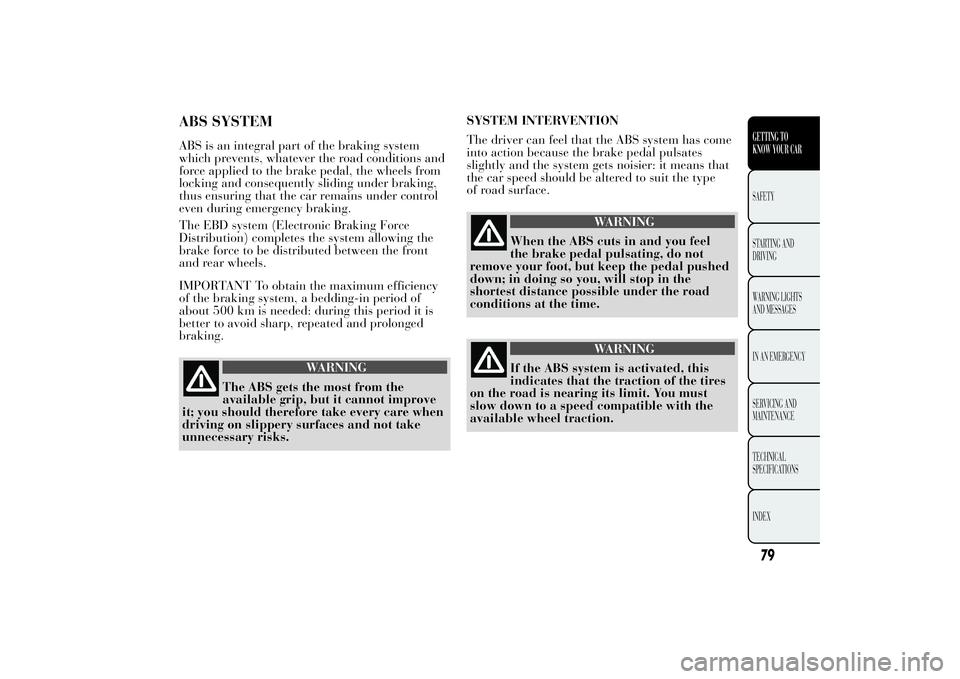
ABS SYSTEMABS is an integral part of the braking system
which prevents, whatever the road conditions and
force applied to the brake pedal, the wheels from
locking and consequently sliding under braking,
thus ensuring that the car remains under control
even during emergency braking.
The EBD system (Electronic Braking Force
Distribution) completes the system allowing the
brake force to be distributed between the front
and rear wheels.
IMPORTANT To obtain the maximum efficiency
of the braking system, a bedding-in period of
about 500 km is needed: during this period it is
better to avoid sharp, repeated and prolonged
braking.
WARNING
The ABS gets the most from the
available grip, but
it cannot improve
it; you should therefore take every care when
driving on slippery surfaces and not take
unnecessary risks.SYSTEM INTERVENTION
The driver can feel that the ABS system has come
into action because the brake pedal pulsates
slightly and the system gets noisier: it means that
the car speed should be altered to suit the type
of road surface.
WARNING
When the ABS cuts in and you feel
the brake pedal
pulsating, do not
remove your foot, but keep the pedal pushed
down; in doing so you, will stop in the
shortest distance possible under the road
conditions at the time.
WARNING
If the ABS system is activated, this
indicates that the
traction of the tires
on the road is nearing its limit. You must
slow down to a speed compatible with the
available wheel traction.
79GETTING TO
KNOW YOUR CARSAFETY
STARTING
AND
DRIVING
WARNING LIGHTS
AND MESSAGES
IN AN EMERGENCY
SERVICING AND
MAINTENANCE
TECHNICAL
SPECIFICATIONS
INDEX
Page 85 of 299

MSR SYSTEM
(Motor Schleppmoment Regelung)
This system is an integral part of the ABS, that
intervenes, if there is sudden downshifting,
restoring torque to the engine, thereby preventing
excessive drive at the drive wheels which,
especially in poor grip conditions, could lead to a
loss in stability of the car.
START&STOP SYSTEMINTRODUCTION
The Start&Stop system automatically stops the
engine each time the car is stationary and starts it
again when the driver wants to move off. In this
way, the car efficiency is increased, by reducing
consumption, dangerous gas emissions and noise
pollution.
The system activates every time the car is started.
OPERATING MODES
Engine stopping mode
With the car stopped, the engine stops with
gearbox in neutral and clutch pedal released.
NoteThe engine can only be stopped
automatically after driving at a speed of more
than about 10 km/h, to prevent the engine from
being repeatedly stopped when driving at walking
pace.
Symbol
appears on the display when the engine
stops.
83GETTING TO
KNOW YOUR CARSAFETY
STARTING
AND
DRIVING
WARNING LIGHTS
AND MESSAGES
IN AN EMERGENCY
SERVICING AND
MAINTENANCE
TECHNICAL
SPECIFICATIONS
INDEX
Page 86 of 299

Engine t mode
Press the clutch pedal to restart the engine.
MANUAL SYSTEM ACTIVATION/
DEACTIVATION
To activate/deactivate the system manually, press
the button
fig. 69 on the dashboard control
trim.
Start&Stop system activation
Start&Stop system activation is signalled by a
message on the display. In this condition, the LED
on the button
is off.
Start&Stop system deactivation
Versions with multifunction display: a message
appears on the display when the Start&Stop
system is deactivated.Versions with reconfigurable multifunction
display: the
symbol and a message appear on
the display when the Start&Stop system is
deactivated.
The LED above the
button is on when the
system is deactivated.
ENGINE STOPPING FAILURE CONDITIONS
When the system is active, due to comfort,
emission control and safety reasons, the engine
does not stop in some conditions, among which:
❒engine still cold;
❒especially cold outside temperature;
❒battery not sufficiently charged;
❒heated rear window activated;
❒windscreen wipers working at maximum speed;
❒particulate filter regeneration (DPF) in progress
(diesel engines only);
❒driver's door not shut;
❒driver's seat belt not fastened;
❒reverse gear engaged (for example, for parking
manoeuvres);
❒for versions equipped with automatic climate
control (for versions/markets, where provided),
if an adequate level of thermal comfort has
not been reached or with MAX-DEF activation;
❒during the first period of use, to initialise the
system.
fig. 69
L0F0044
84GETTING TO
KNOW YOUR CAR
SAFETY
STARTING
AND
DRIVING
WARNING LIGHTS
AND MESSAGES
IN AN EMERGENCY
SERVICING AND
MAINTENANCE
TECHNICAL
SPECIFICATIONS
INDEX
res arting
Page 87 of 299

In these cases, the display shows a message and -
for versions/markets, where provided - the symbol
flashes on the display.
If climate comfort is to be favoured, the
Start&Stop system can be disabled,
for a continuous operation of the
climate control system.
ENGINE RESTARTING CONDITIONS
For reasons of comfort, limiting harmful emissions
and safety purposes, the power unit can restart
automatically without any action on behalf of the
driver if certain conditions are met, including:
❒battery not sufficiently charged;
❒windscreen wipers working at maximum speed;
❒reduced braking system vacuum (e.g. if the
brake pedal is pressed repeatedly);
❒car moving (e.g. when driving on roads with a
gradient);
❒engine stopping by Start&Stop system for over
3 minutes;
❒for versions equipped with automatic climate
control (for versions/markets where provided),
to enable suitable thermal comfort or with
MAX-DEF activation.With gear engaged, automatic engine restarting is
possible only by fully depressing the clutch pedal.
The driver is informed by the displaying of a
message on the display and - for versions/markets,
where provided - by the flashing of the symbol
.
Notes
If the clutch is not pressed, 3 minutes after the
engine stops, the engine can be restarted only
using the ignition key.
In cases when the engine stops and this is not
desired, due for example to the clutch pedal being
released sharply with a gear engaged, if the
Start&Stop system is activated, the engine can be
restarted by fully depressing the clutch pedal or
by placing the gear lever in neutral.
SAFETY FUNCTIONS
When the engine is stopped by the Start&Stop
system, if the driver releases his/her seat belt and
opens the driver's or passenger's door, the engine
can be restarted only using the ignition key.
The driver is informed by a buzzer and by the
flashing of the symbol
on the display; on some
versions, a message is displayed as well.
85GETTING TO
KNOW YOUR CARSAFETY
STARTING
AND
DRIVING
WARNING LIGHTS
AND MESSAGES
IN AN EMERGENCY
SERVICING AND
MAINTENANCE
TECHNICAL
SPECIFICATIONS
INDEX
Page 88 of 299
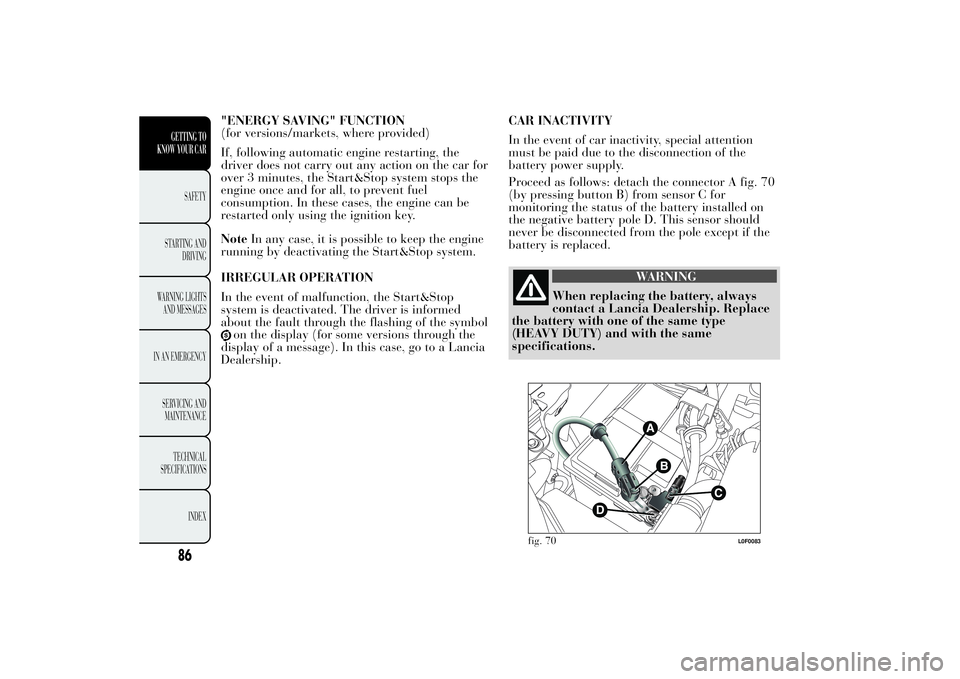
"ENERGY SAVING" FUNCTION
(for versions/markets, where provided)
If, following automatic engine restarting, the
driver does not carry out any action on the car for
over 3 minutes, the Start&Stop system stops the
engine once and for all, to prevent fuel
consumption. In these cases, the engine can be
restarted only using the ignition key.
NoteIn any case, it is possible to keep the engine
running by deactivating the Start&Stop system.
IRREGULAR OPERATION
In the event of malfunction, the Start&Stop
system is deactivated. The driver is informed
about the fault through the flashing of the symbol
on the display (for some versions through the
display of a message). In this case, go to a Lancia
Dealership.CAR INACTIVITY
In the event of car inactivity, special attention
must be paid due to the disconnection of the
battery power supply.
Proceed as follows: detach the connector A fig. 70
(by pressing button B) from sensor C for
monitoring the status of the battery installed on
the negative battery pole D. This sensor should
never be disconnected from the pole except if the
battery is replaced.
WARNING
When replacing the battery, always
contact a Lancia
Dealership. Replace
the battery with one of the same type
(HEAVY DUTY) and with the same
specifications.
fig. 70
L0F0083
86GETTING TO
KNOW YOUR CAR
SAFETY
STARTING
AND
DRIVING
WARNING LIGHTS
AND MESSAGES
IN AN EMERGENCY
SERVICING AND
MAINTENANCE
TECHNICAL
SPECIFICATIONS
INDEX
Page 89 of 299

JUMP STARTING
When jump starting, never connect the negative
lead (-) of the auxiliary battery to the negative
pole A fig. 71 of the car battery, but rather to an
engine/gearbox earth point.IMPORTANT NOTES
WARNING
Before opening the bonnet, make sure
that the engine
is off and that the
ignition key is in the STOP position. Follow
the instructions on the dedicated label on the
front crossmember fig. 72. We recommend
that you remove the key from the ignition
if other people remain in the vehicle. Exit
from the car only after having removed the
ignition key or having rotated it to the STOP
position. During refuelling, make sure the
car has been stopped and the key is in STOP
position.
fig. 71
L0F0084
fig. 72
L0F0204
87GETTING TO
KNOW YOUR CARSAFETY
STARTING
AND
DRIVING
WARNING LIGHTS
AND MESSAGES
IN AN EMERGENCY
SERVICING AND
MAINTENANCE
TECHNICAL
SPECIFICATIONS
INDEX
Page 91 of 299
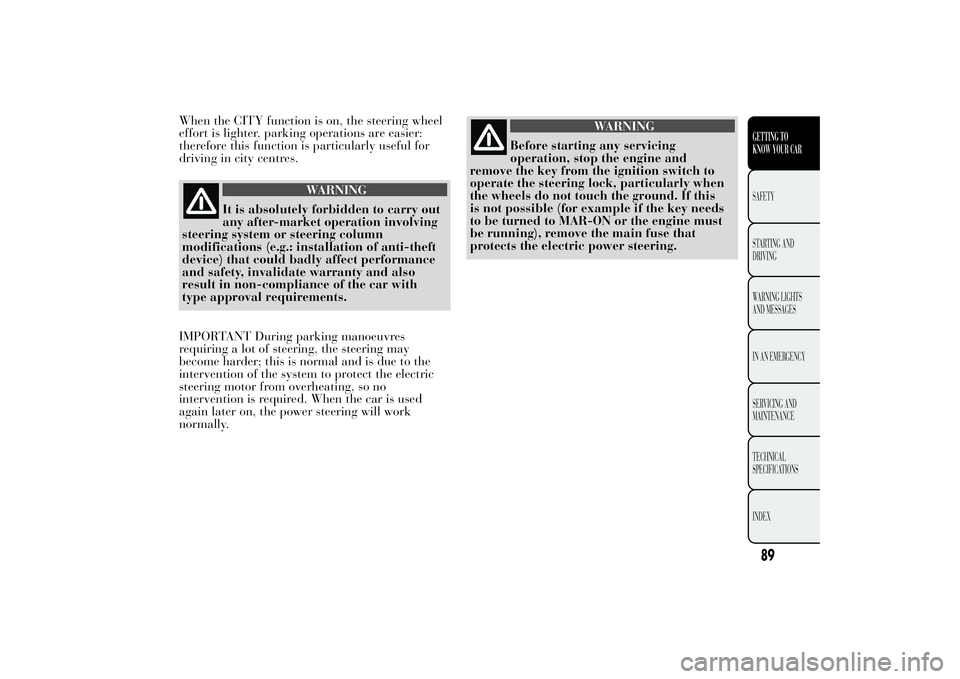
When the CITY function is on, the steering wheel
effort is lighter, parking operations are easier:
therefore this function is particularly useful for
driving in city centres.
WARNING
It is absolutely forbidden to carry out
any after-market
operation involving
steering system or steering column
modifications (e.g.: installation of anti-theft
device) that could badly affect performance
and safety, invalidate warranty and also
result in non-compliance of the car with
type approval requirements.
IMPORTANT During parking manoeuvres
requiring a lot of steering, the steering may
become harder; this is normal and is due to the
intervention of the system to protect the electric
steering motor from overheating, so no
intervention is required. When the car is used
again later on, the power steering will work
normally.
WARNING
Before starting any servicing
operation, stop the
engine and
remove the key from the ignition switch to
operate the steering lock, particularly when
the wheels do not touch the ground. If this
is not possible (for example if the key needs
to be turned to MAR-ON or the engine must
be running), remove the main fuse that
protects the electric power steering.
89GETTING TO
KNOW YOUR CARSAFETY
STARTING
AND
DRIVING
WARNING LIGHTS
AND MESSAGES
IN AN EMERGENCY
SERVICING AND
MAINTENANCE
TECHNICAL
SPECIFICATIONS
INDEX
Page 98 of 299
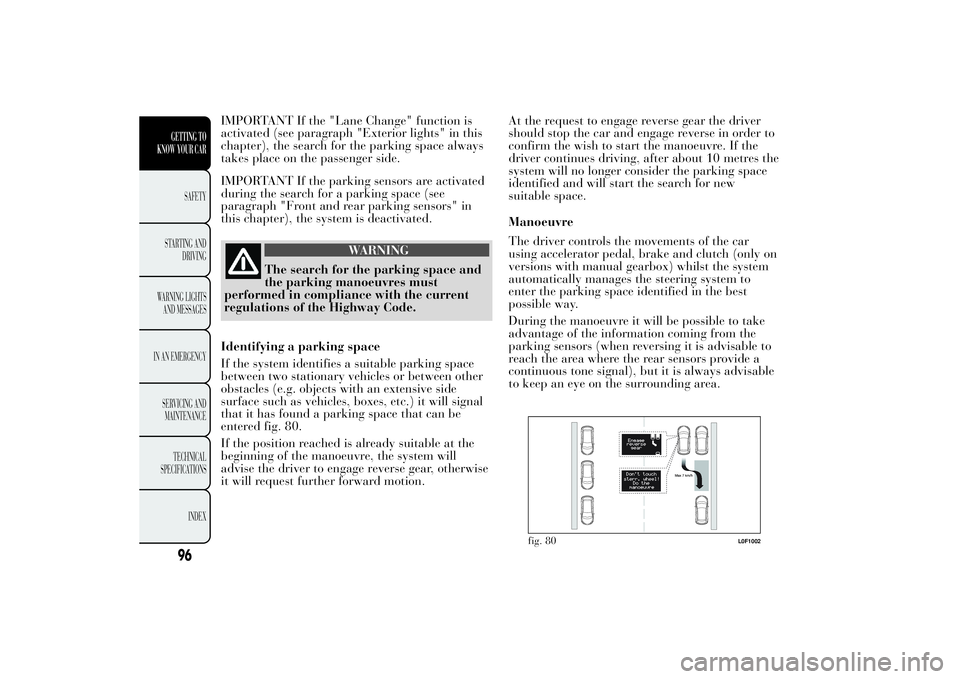
IMPORTANT If the "Lane Change" function is
activated (see paragraph "Exterior lights" in this
chapter), the search for the parking space always
takes place on the passenger side.
IMPORTANT If the parking sensors are activated
during the search for a parking space (see
paragraph "Front and rear parking sensors" in
this chapter), the system is deactivated.
WARNING
The search for the parking space and
the parking manoeuvres
must
performed in compliance with the current
regulations of the Highway Code.
Identifying a parking space
If the system identifies a suitable parking space
between two stationary vehicles or between other
obstacles (e.g. objects with an extensive side
surface such as vehicles, boxes, etc.) it will signal
that it has found a parking space that can be
entered fig. 80.
If the position reached is already suitable at the
beginning of the manoeuvre, the system will
advise the driver to engage reverse gear, otherwise
it will request further forward motion.At the request to engage reverse gear the driver
should stop the car and engage reverse in order to
confirm the wish to start the manoeuvre. If the
driver continues driving, after about 10 metres the
system will no longer consider the parking space
identified and will start the search for new
suitable space.
Manoeuvre
The driver controls the movements of the car
using accelerator pedal, brake and clutch (only on
versions with manual gearbox) whilst the system
automatically manages the steering system to
enter the parking space identified in the best
possible way.
During the manoeuvre it will be possible to take
advantage of the information coming from the
parking sensors (when reversing it is advisable to
reach the area where the rear sensors provide a
continuous tone signal), but it is always advisable
to keep an eye on the surrounding area.
fig. 80
L0F1002
96GETTING TO
KNOW YOUR CAR
SAFETY
STARTING
AND
DRIVING
WARNING LIGHTS
AND MESSAGES
IN AN EMERGENCY
SERVICING AND
MAINTENANCE
TECHNICAL
SPECIFICATIONS
INDEX
Page 99 of 299
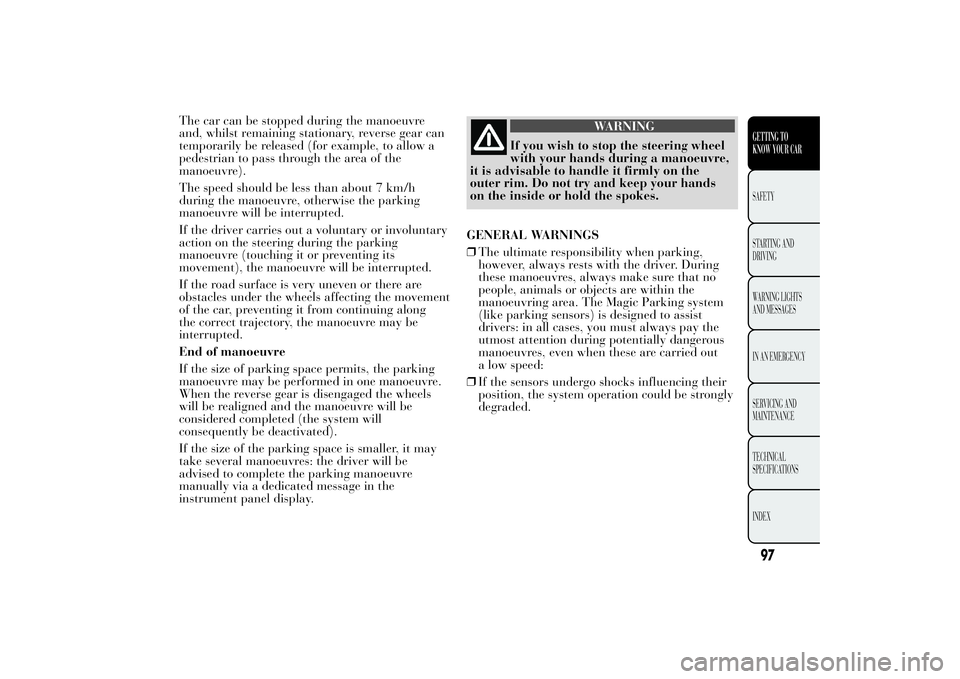
The car can be stopped during the manoeuvre
and, whilst remaining stationary, reverse gear can
temporarily be released (for example, to allow a
pedestrian to pass through the area of the
manoeuvre).
The speed should be less than about 7 km/h
during the manoeuvre, otherwise the parking
manoeuvre will be interrupted.
If the driver carries out a voluntary or involuntary
action on the steering during the parking
manoeuvre (touching it or preventing its
movement), the manoeuvre will be interrupted.
If the road surface is very uneven or there are
obstacles under the wheels affecting the movement
of the car, preventing it from continuing along
the correct trajectory, the manoeuvre may be
interrupted.
End of manoeuvre
If the size of parking space permits, the parking
manoeuvre may be performed in one manoeuvre.
When the reverse gear is disengaged the wheels
will be realigned and the manoeuvre will be
considered completed (the system will
consequently be deactivated).
If the size of the parking space is smaller, it may
take several manoeuvres: the driver will be
advised to complete the parking manoeuvre
manually via a dedicated message in the
instrument panel display.
WARNING
If you wish to stop the steering wheel
with your hands
during a manoeuvre,
it is advisable to handle it firmly on the
outer rim. Do not try and keep your hands
on the inside or hold the spokes.
GENERAL WARNINGS
❒The ultimate responsibility when parking,
however, always rests with the driver. During
these manoeuvres, always make sure that no
people, animals or objects are within the
manoeuvring area. The Magic Parking system
(like parking sensors) is designed to assist
drivers: in all cases, you must always pay the
utmost attention during potentially dangerous
manoeuvres, even when these are carried out
a low speed:
❒If the sensors undergo shocks influencing their
position, the system operation could be strongly
degraded.
97GETTING TO
KNOW YOUR CARSAFETY
STARTING
AND
DRIVING
WARNING LIGHTS
AND MESSAGES
IN AN EMERGENCY
SERVICING AND
MAINTENANCE
TECHNICAL
SPECIFICATIONS
INDEX